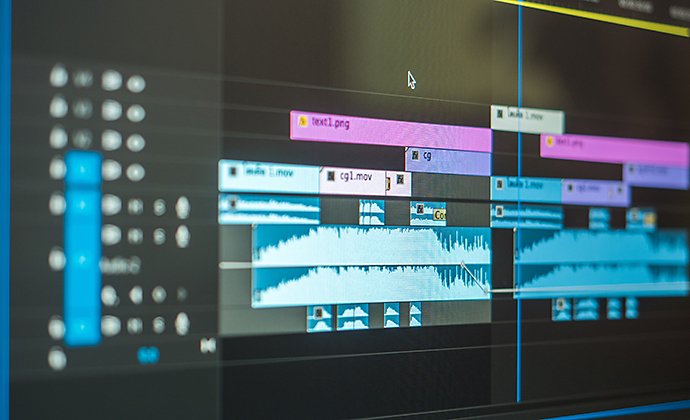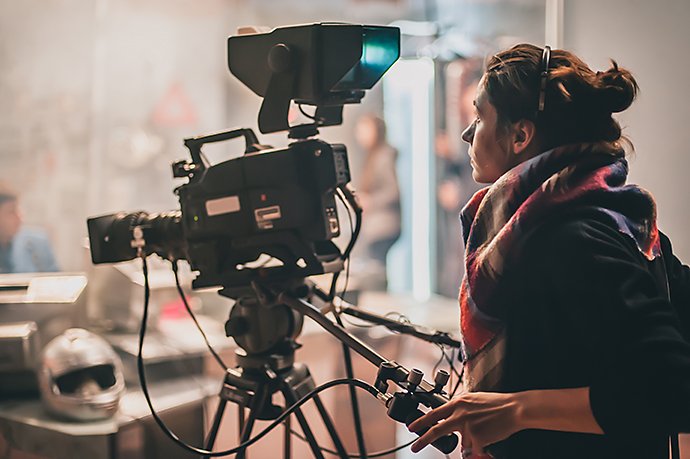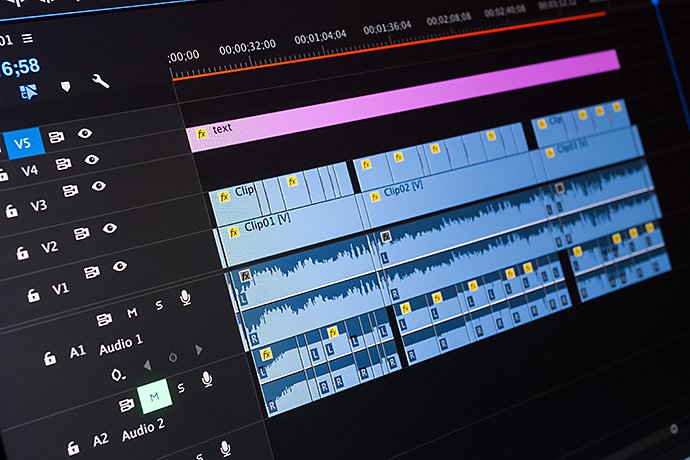Video post-production: everything you need to know.
Post-production is the final stage of video creation. Once you’ve shot your footage, the finishing touches will need to be added to your film. The process can involve many individuals and teams, from sound mixers and voiceover artists to editors and colour graders. Learn more about the stage of the process in our comprehensive guide.

What is involved in video post-production?
Post-production is the third and final stage of video creation. It’s a detailed process that involves many different services, skillsets and types of professional software, all working together to create a final version of your video or film. Once your footage has been shot, you’ll enter the post-production phase of creation, editing your reels of film together and finalising the look, sound and feel of your film.
Key differences between pre-production, production and post-production.
As the third stage of the video creation process, post-production follows on from the first stage, pre-production and the second stage, production.
Pre-production.
Pre-production is the planning phase. It encompasses every stage of work that occurs before a film is shot. This includes producers, directors, cinematographers, storyboard artists and more. In this phase, everything for the shoot will be planned out and the general look of the film will begin to take shape through storyboarding and a shot list. Equipment and staff will be hired, actors and locations chosen and everything prepared for the shoot.
What’s involved?
Scripting, Storyboarding, Shot List, Hiring, Casting, Costume & Makeup Creation, Set Building, Financing and Insurance, Location Scouting.
Who’s involved?
Directors, Writers, Producers, Cinematographers, Storyboard Artists, Location Scouts, Costume & Makeup Designers, Set Designers, Artists, Casting Directors.
Production.
This is the shooting phase. Footage is gathered by filming scenes live. Often, footage will be shot and saved after each day, ready to send to the post-production team as soon as possible. Depending on the length of a film and the amount of footage needed, some shoots can take days, while others can take months. Voiceovers and sound will be recorded on location, where needed.
What’s involved?
Filming, On-location Sound Recording, Reshoots.
Who’s involved?
Directing Team, Cinematography Team, Sound Team, Grips & Equipment Operators, Runners, Costume & Makeup Team, Actors, Stunt Team.

Post-production.
This last stage is where the film takes shape as an actual product. Footage is brought together, sound is recorded and added and the finishing touches are put to the film ahead of marketing and release.
What’s involved?
Editing, Colour Grading & Correction, Visual Effects & Animation, Sound Recording, Foley Recording, Script Sound Recording, Sound Mixing & Editing, Soundtrack & Music.
Who’s involved?
Editors, Visual Effects Artists, Animators, Composers, Sound Mixers & Editors, Sound Recordists, Colour Graders, Foley Artists, Voiceover Artists, Actors.
The 5 stages of video post-production.
Post-production is a very detailed process involving many individuals, but it can be broken down into five distinct stages:
- Logging footage. You won’t want to lose your footage, so make sure it is saved and clearly labelled ahead of moving into the editing process. Depending on the length of the film and your computer processing power, this could take several days.
- Assembling footage. This is the beginning of the editing process. All the footage is gathered and any sub-standard footage - outtakes, misread lines, staff in the back of shot, for example - is deleted. Gather several takes from each individual scene into folders, labelled by scene name, for ease later. This whole process may take a few days. Footage from each scene is then placed into an ordered timeline as the film begins to take shape.
- Rough cut. A rough version of the film is edited together. This can easily take a couple of weeks depending on your processing power and the number of editors involved. The timeline is cleaned up, with final takes of each scene chosen and a rough edit put together. The post-production sound team will also work on the film at this stage, re-recording clearer voice acting, adding sound effects and composing music.
- Fine cut. The film is tweaked and tightened up and finalised scenes begin to take shape. Pay attention to each individual frame, making sure the film works together and there are no obvious mistakes, such as changing costumes or changing camera angles.
- Final cut. The final cut is where all the remaining work takes place, including colour grading and correction, motion graphics and visual effects work ahead of release.

Who is involved in post-production?
Post-production involves many talented individuals, from a composer writing the musical score, to large teams of visual effects artists working on the motion graphics and computer special effects.
These are just some of the skilled professionals who tend to work in post-production.
Picture Editors.
An editor or editors, is responsible for splicing the film footage into a finished product. They take the reels from the location shoot and cut it all into a finished version of the film. They often work closely with the director and adhere to the storyboards and screenplay created during pre-production to ensure the story makes sense and that the final edit matches the vision of the director.
Foley Artists (AKA Sound Editors).
Sound recorded on location is often unusable in the final version of a film. It might be difficult to hear the actors’ voices over the wind or it may be they spoke too softly. Much of a film’s sound is recorded afterwards and added to the final edit.
Actors re-record lines in a soundproof booth and sound effects are created by a team of professionals known as foley artists. They have access to a whole room (or two) of different materials and record everything from footsteps and clothes rustling to car engines and gunshots. A Foley Artist will work closely with Automated Dialogue Replacement (ADR) supervisors and dialogue editors to create sound effects and re-record actors’ lines.

Music Editors.
The music editor or composer, is in charge of creating the music for a film. Either they will use tracks by established recording artists or they’ll create the music for scratch with a team of musicians.
Sound Mixers.
A sound mixer usually works as part of a team. They take all the film’s sound, from voices and music to footsteps and wind noises and ensure it’s mixed correctly for volume and the edit of the film. It’s their job to ensure the actors can be heard clearly by making sure their lines are louder than other sounds in the scene. It would be odd, for example, if the sound of someone’s footsteps on a pavement were much louder than the car driving past in the same scene.
VFX Artists.
Visual effects artists (VFX) are the team behind the film’s computer-generated images and effects. These effects aren’t just monsters, aliens and blockbuster elements in the latest Hollywood release either. Visual effects can include altering backgrounds slightly or creating new ones following green screen shooting. VFX are different to special effects, however, which usually include things like monster makeup, explosions and stunt work.

Post-production involves many skilled professionals, not least the few mentioned above. There can be hundreds of artists and animators working on the latter stages of a film’s production, sometimes taking months to finalise the motion graphics or perfecting a film’s musical composition. Other roles include trailer editors, responsible for putting together a film’s marketing trailer and credit artists, who create the credits showcasing the names of everyone involved in the production.
Understanding the post-production process.
Post-production is a detailed, multi-step process that involves many different teams working in tandem to create the finished product ready for release. Find out what’s involved in each stage of the process.
Editing format.
Raw video footage takes up a huge amount of computer file space, especially if it’s high definition. First off, make sure you have enough space to store the footage.
You’ll then need to select an editing format. Video is edited in a different file format to the files used for the final delivery of a video, such as MPEG. This is because you’ll need to access the raw video footage for the editing stage, which will likely consist of hundreds of different individual files from your on-location shoot. Later, when exporting the final product, you can master and compress your finished film into a smaller file size.
The two types of file codec are:
- Intra-frame - for editing. All the footage is stored and accessed as individual frames ready for cutting and splicing. File sizes are quite large, but it’s important to use detail at this stage.
- Inter-frame - for delivery. The footage is not stored individually, with a computer using information from previous frames to help it to process the file data. File sizes are much smaller and easier to transport or send, ready for uploading to the Internet or exhibiting live.
Using a video editor.
You’ll then need to choose your video editing software. You could start with Adobe Premiere Pro. Which video editing software you choose can be personal preference, but they all perform differently, with their own add-ons, features and interfaces.

Clips are placed in a timeline to create one singular full-length version of your video. You can choose to cut between different camera angles and scenes by moving the clips around in the timeline and tweaking the length of each of them individually.
Get to grips with video editor software
Video editing.
Once you have a finished edit and the creative team is happy with how the story plays out on screen, the film is ready to enter the latter stages of post-production. To prepare it for release, the film’s images and sound will need to be improved and all mistakes ironed out.
Colour correction.
Colour correction, also known as colour grading, is the art of improving the overall look of the film by manipulating the colour palette of each scene. When shooting on location, there may have been issues with lighting and overcast weather. You may, on the other hand, want to make artistic choices with the colour of costumes or scenery.
Enter colour correction. A colour grader will amend the way a film looks, saturating certain colours, adding filters to certain scenes and improving the lighting of others - similarly to how you may edit photos at home. It’s their job to ensure the film has a similar look throughout and that scenes generally have the same aesthetic feel.
Visual effects.
Modern blockbusters have incredible special effects, including monsters, pirate ships and suchlike. Of course, many of these things don’t exist or are difficult and prohibitively expensive to build in real life. Enter the visual effects team, which uses powerful computer tools to create monsters and pirate ships for the world of the film.

Big budget special effects aren’t the only things the VFX team create, however. They may be responsible for generating the backgrounds for green screen shoots, for films where the background might be fantasy or difficult to replicate in real life.
Main titles and credits.
Graphics and titles will be added next, creating the opening and closing elements of the film. Any in-film graphics are added too, such as language subtitles or location stamps. Also, don’t forget to include everyone who has been involved in your production in the film’s closing credits.
Sound editing.
A film’s sound is just as important as the images. Sound problems can be disconcerting and risk pulling the audience out of the world of the film. Poorly mixed sound can make it difficult to hear what the characters are saying, meaning vital elements of the story could be missed.
ADR: re-recording audio.
ADR or Automated Dialogue Replacement, is the stage in which the screenplay is re-recorded for slotting into the film’s edit. Sound recorded on set can often be poor quality - you might find actors are difficult to hear or you’ve recorded the rustling of a microphone accidentally.
Dialogue is recorded in a soundproof booth by ADR teams, working with actors and voiceover artists to re-record lines. This is then added to the final edit - the tricky bit is syncing the spoken words with the actor’s lip movements.

Considering foley sounds.
Foley artists are responsible for recreating sounds from the world of the film, such as footsteps, gunfire and car engines. They’ll record the sounds using materials in their sound studio before adding into the film where required.
Music and effects.
A composer will add the music to the film. This can be an original score composed for the film exclusively or existing music for which they’ll need to buy the rights. Music will then be overlaid in the scenes where it is needed.
Mixing audio.
The sound mixer brings together all the sound elements and mixes them to make sure they can be heard at a suitable volume. A mixer will want voices to sound louder than a musical score, for example, so the audience can hear what is being said. They may also add sound effects, such as reverb or an echo effect if the characters are in a cave.

Creating graphics.
You may then need a graphics artist to add any finishing graphical touches to the film, such as on-screen elements or scene transitions. Once they have been added, the film is ready to be exported for distribution.
Making the trailer.
You’ll want people to be excited about your upcoming release. For that, you’ll need to market it effectively. A trailer or a short collection of clips from your film, is a good way to do this. A trailer editor will take exciting elements of the film and edit them together to create a short video that drums up anticipation ahead of the big launch.
There may be more steps involved in post-production than you thought. However, making sure it is carried out properly will enable you to add the final flourishing touches and make your footage truly shine. Need further support? Find out more about video editing.
You might also be interested in…
Elige el formato de video adecuado.
Encuentra el mejor formato para transmitir, descargar o almacenar los videos en un equipo.
Reduce the size of a video file with Adobe Media Encoder.
Find out how to reduce the size of video files without reducing quality.
Cómo editar vídeos: todo lo que debes saber.
Aprende los principios de la edición de vídeo y consejos prácticos tanto para pantallas grandes como pequeñas.
Encuentra la relación de aspecto adecuada para tu video.
Descubre cómo hacer corresponder la relación de aspecto con la sustancia y estilo de tu proyecto.
Obtén Adobe Premiere Pro
Puedes crear producciones perfectas con el software de edición de video líder en su sector.
7 días gratis, luego Ar$ 13.491,50 /mes.



